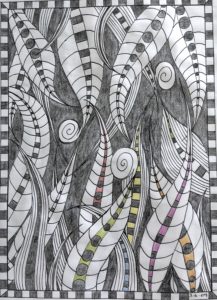Words can often be an inadequate means of describing our thoughts or dreams. Drawing, on the other hand, can be the choreography of constructing a design vision for all to see, without the need to utter one single word.
I’ve been watching a four-part video series – 15 years old I might add, but still, one of the best I’ve seen, on the art of drawing. It’s dissected under a fine microscope – and then some. More on the video later.
It’s prompted me to consider my own drawing – my ability, knowledge and style. I don’t draw enough, although I love it, and I’m always trying to add to my knowledge, but there’s just so much out there. Plus my style is my style – even I can see that now and appreciate that it’s just the way it is, so I need to go with the flow.
It’s taken me years to get to this point. I suppose what this video’s done, is to make me think of the different ways I can look at drawing and interpret new ideas – and that’s a really interesting concept – to just look at the various ways people practice the art drawing for design. Think architecture, life-drawing, stage-sets, fashion, even surgery – it all starts with a line. This’s one area I hadn’t even considered as a whole – in isolation yes, occasionally, but as an ensemble, never.
Without showing how to draw, this video series has inspired me to look deeper into drawing creatively, the different genres associated with applying drawing – and some of them were a little bizarre, to say the least, but equally, fascinating, provocative and creative.
For instance, the surgeon who uses drawing as an exercise in hand-eye coordination as well as a teaching tool, using blood. Cartoons and comic books, both old and modern-day, underdrawings on ancient frescoes, something called The Museum of Paper which houses image after image of drawings relating to the natural world. From world-famous artists such as Da Vinci and Picasso to the beautifully expressive drawings of an autistic five-year-old. This series is really thought-provoking and impressive.
Making marks on paper for some is a driving force, right down to the finest detail. For others, a more abstract approach provides the same connection to context and meaning – or simply that compelling need to draw. Then there are others who combine the two.
I think I’m somewhere in between. I love simplicity, yet my work is intricate. I love abstraction but tend to work in a highly stylized, naturalistic way. This series has made me look at how I use the marks I make in a design style – cartoons for instance. The Bayeux Tapestry’s a cartoon – a snapshot of individual, embroidered panels, which, when joined together tell the story as a whole. Simple, yet highly effective.
‘The Secret of Drawing,’ is a four-part series presented by Andrew Graham-Dixon, uploaded to YouTube by David Surman. This is the link to episode one ‘ The Line of Enquiry.’
This series is absolutely fascinating – one I’ll be watching again. I hope you feel the same.

